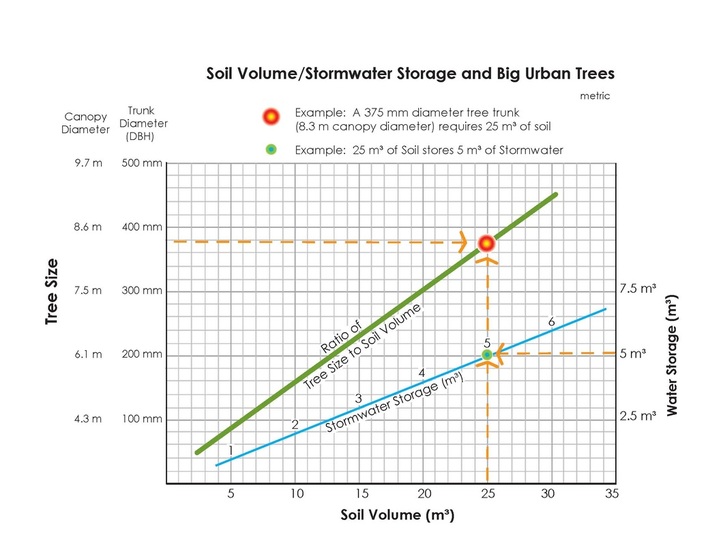Green infrastructure is an approach used to maintain healthy waters, provide multiple environmental benefits and support sustainable communities. Green infrastructure provides multiple benefits or services unlike single purpose hard infrastructure. A stormwater pipe for example can convey water away from a site but it cannot evapotranspire it or infiltrate and filter it like trees, plants and soil do. Green infrastructure uses vegetation and soil to manage rainwater where it falls. Others services beside stormwater management provide are flood and drought mitigation, heating and cooling benefits and recreation to name but a few. Green infrastructure can be integrated with traditional stormwater management to provide a higher level of efficiency and reduce strain on the hard infrastructure.
Urbanization changes the hydrologic cycle
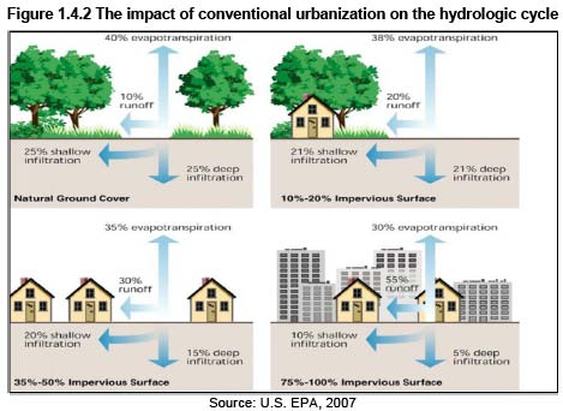
What has changed with urbanization?
- Increased Compaction and loss of soil structure
- Loss of Organic Matter
- Loss of biological activity in the soil
- Reduced ability to hold water, oxygen and exchange gases
- Reduced evapotranspiration
- Increased run-off of precipitation, less infiltration
- Increased use of pesticides and fertilizers
- Increased Nutrient Loading of nearby waterways
Pre-development
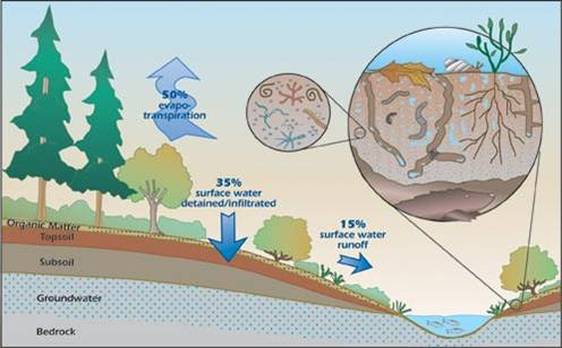
Undisturbed Hydrology
Healthy Native Soils:
- Provides high rates of water infiltration and retention
- Minimizes surface water runoff and erosion
- Traps sediments, heavy metals and excess nutrients and biodegrades chemical contaminants
- Encourages vigorous protective vegetative cover
- Supports beneficial soil life that limits pests and disease, and supply plant nutrients reducing need for fertilizers and pesticides that may contaminate waterways.
- Increase the life span of trees
- Provides high rates of water infiltration and retention
- Minimizes surface water runoff and erosion
- Traps sediments, heavy metals and excess nutrients and biodegrades chemical contaminants
- Encourages vigorous protective vegetative cover
- Supports beneficial soil life that limits pests and disease, and supply plant nutrients reducing need for fertilizers and pesticides that may contaminate waterways.
- Increase the life span of trees
Post-development
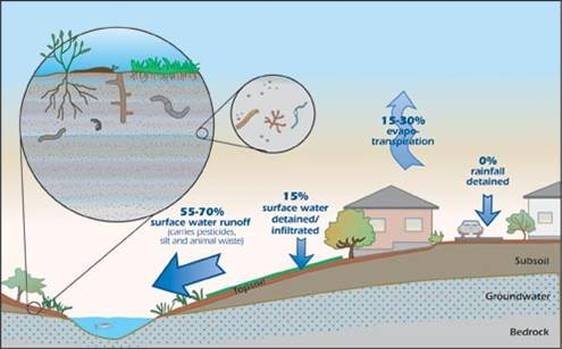
Disturbed Hydrology
During development, soil functions are often impaired by topsoil loss and compaction:
- Decreases surface water infiltration and storage
- Increases surface water runoff, including contamination from roadways and yards.
- Increases erosion and flooding
- Degradation of aquatic habitat and life.
- Reduces beneficial soil life
- Impairs tree and plant growth and pest and disease resistance
- Decreases surface water infiltration and storage
- Increases surface water runoff, including contamination from roadways and yards.
- Increases erosion and flooding
- Degradation of aquatic habitat and life.
- Reduces beneficial soil life
- Impairs tree and plant growth and pest and disease resistance
Low Impact Development utilizes the services provided by Green Infrastructure
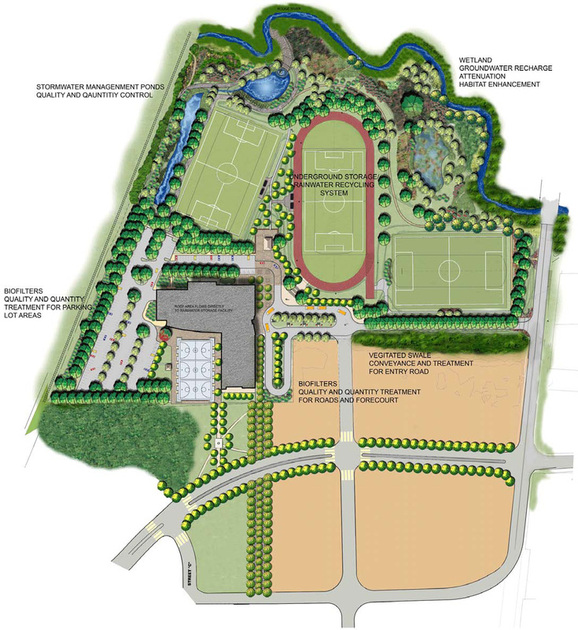
LID example: Bill Crothers Secondary School Markham ON, TRCA
Virtually every component in the landscape becomes part of the stormwater management system. It tends towards self-sustaining creating longer term cost benefits than conventional designs. Every square metre of a development are viewed for their potential contribution with the emphasis on how to best maximize each.
"Green Infrastructure such as trees, shrubs, grasses and soil become the primary responders in this system and are as critical to our well-being as those in our healthcare system"
The Basic ABC's of LID: Trees (all vegetation), Soil and Water
(A) Trees: The original multi-taskers
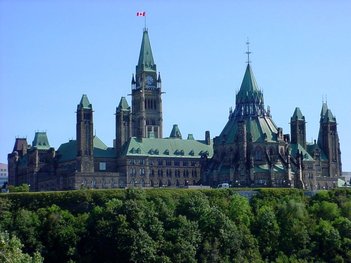
City of Ottawa 2008
Analysis with cityGreen Software of the City of Ottawa's 27% urban forest cover provided the following statistics of services provided:
• removes approximately 629,323 kgs of air pollutants per year which translates
into a dollar value of $3,955,713.
• stored 1,011,745 tonnes of carbon and sequestered an additional 7,876/year.
• provided the equivalent of 3,843,945 cu meters of stormwater storage which
represents a savings of $219,104,850 if all this stormwater was captured in built SWM facilities.
• removes approximately 629,323 kgs of air pollutants per year which translates
into a dollar value of $3,955,713.
• stored 1,011,745 tonnes of carbon and sequestered an additional 7,876/year.
• provided the equivalent of 3,843,945 cu meters of stormwater storage which
represents a savings of $219,104,850 if all this stormwater was captured in built SWM facilities.
The larger the trees, the greater the services provided
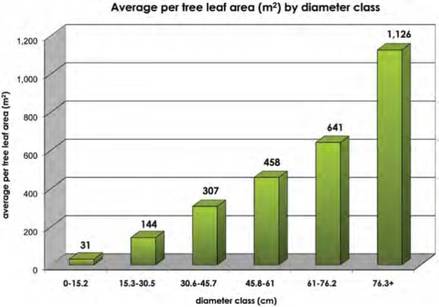
Andy Kenney
An increase in tree size produces an exponential increase in the size of the services provided by the tree partly as a result of the increase in leaf area and biomass of larger trees.
The most common limiting factor in a trees ability to reach maturity and maintain health is soil volume and quality. This also has a direct impact on stormwater management. The graph below shows one of the relationships between trees, soil and water.
(B) Soil: Dynamic and Alive
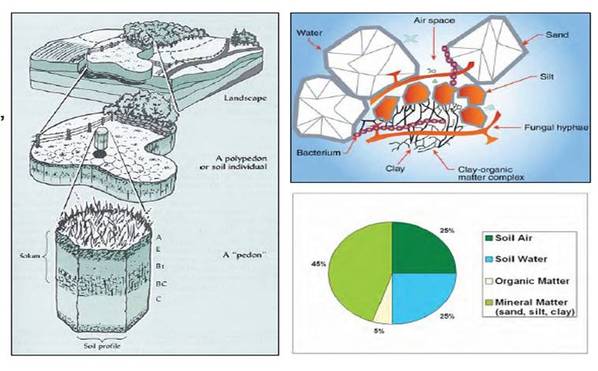
Physical and chemical soil properties depend
on micro-organisms and other soil dwellers
found abundantly in healthy soils to provide:
- Soil Structure
- Water infiltration and holding capacity
- Pollutant removal
- Cation exchange capacity
- Nutrient cycling
Soil is the interface between all other natural components (air, water, vegetation) and a critical link in all ecological processes. Soil function has historically being overlooked and under-managed in the urban environment.
on micro-organisms and other soil dwellers
found abundantly in healthy soils to provide:
- Soil Structure
- Water infiltration and holding capacity
- Pollutant removal
- Cation exchange capacity
- Nutrient cycling
Soil is the interface between all other natural components (air, water, vegetation) and a critical link in all ecological processes. Soil function has historically being overlooked and under-managed in the urban environment.
(C) Water: The Paradox
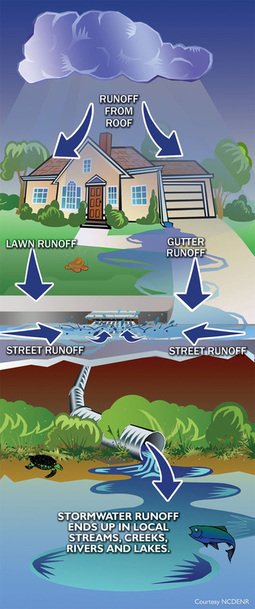
The quality of our living and man-made environment is dependent on water. The quality of water is dependent on the living and man-made environment. There is no separation and hence the requirement for an ecosystem approach to land development.
All future land development will require addressing this fundamental reality if sustainability is a criteria.
Low Impact Development and Green Infrastructure design principles are great contributors to the goal of sustainability and the triple bottom line.
